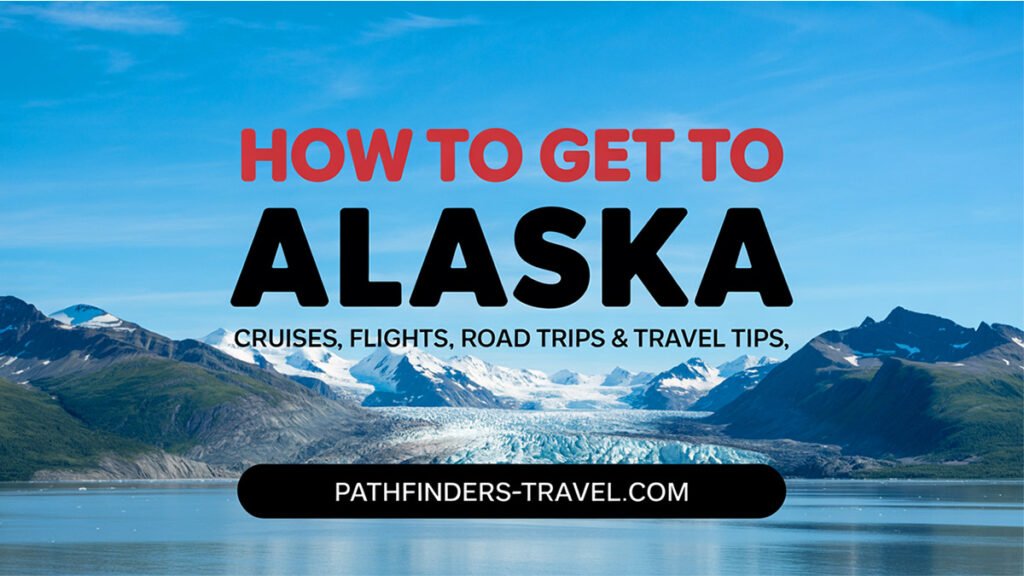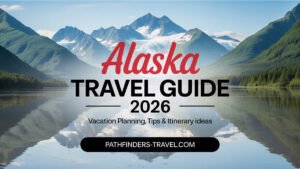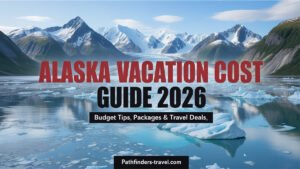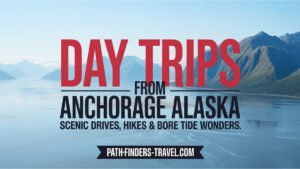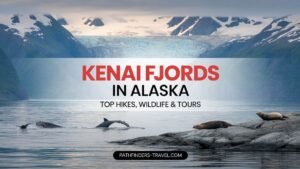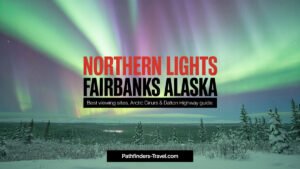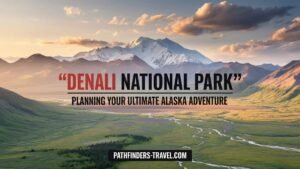Estimated reading time: 21 minutes
Key Takeaways
- Alaska is the largest U.S. state, spanning over 663,000 square miles, with diverse landscapes requiring careful travel planning
- Cruises offer spectacular coastal views from May to September, while flights provide year-round access to major Alaskan cities
- Road trips, particularly along routes like the Dalton Highway, provide an immersive way to experience Alaska’s remote beauty
- Local transportation options include rental vehicles, shuttles, train travel, and boat services that connect major destinations
- Preparation is essential – travelers should plan for changing weather conditions and bring emergency supplies when venturing into remote areas
Table of Contents
- Introduction
- Overview of Alaska’s Vast Terrain and Unique Challenges
- Transportation Options – Alaska Cruise vs. Flight
- Alaska Road Trip Guide and Getting Around Alaska
- Special Focus – Dalton Highway Road Trip
- Alaska Travel Requirements and Getting Around Locally
- Frequently Asked Questions about Alaska Transportation & Accessibility
- Conclusion
Introduction
How to Get to Alaska: Complete Transportation Guide
Alaska stands as America’s last true frontier – a vast, remote destination renowned for its unmatched natural beauty. From towering mountains and pristine glaciers to dramatic coastlines and abundant wildlife, the 49th state offers experiences that simply cannot be found elsewhere. If you’re wondering how to get to Alaska, you’ve come to the right place. This comprehensive guide will walk you through the main transportation methods and provide practical travel tips to help you effectively navigate Alaska’s remote and wild landscapes.
Want to see this for yourself? Click here to watch the full travel documentary in 4K UHD resolution.
Overview of Alaska’s Terrain, Climate, and Transportation Challenges
Enormous Size & Sparsity
Alaska is the largest U.S. state, spanning over 663,000 square miles – that’s more area than Texas, California, and Montana combined. To put this in perspective, Alaska is larger than the combined areas of the United Kingdom, Germany, Japan, and France. Despite this immense size, it’s home to only about 730,000 people, fewer than a single city like San Antonio, Texas [SOURCE]. This low population density means many areas remain remote and isolated, with limited infrastructure connecting communities.
The state’s sheer size presents unique transportation challenges. Many destinations within Alaska are separated by hundreds of miles of wilderness, mountains, or water. Some towns and villages are entirely off the road system, accessible only by plane or boat. This isolation is part of what makes Alaska travel so adventurous – and why planning your transportation carefully is essential.
Weather & Landscape Challenges
Alaska’s climate varies dramatically across its regions. Coastal areas like Juneau and Sitka experience relatively temperate conditions influenced by ocean currents, while interior regions such as Fairbanks can see extreme temperature swings – from -50°F in winter to 90°F in summer [SOURCE].
These climatic variations significantly impact transportation. Winter brings snow-covered roads, potential whiteout conditions, and frozen waterways. Spring thaws can create muddy, nearly impassable roads. Summer offers more reliable conditions but can bring its own challenges, including wildfires that occasionally close highways.
The landscape itself presents obstacles – mountain ranges divide regions, vast rivers cut across travel routes, and glaciers shape the terrain. Some communities sit on islands or in fjords with no road connections to the mainland.
Travel Planning Necessities
Given these challenges, flexible itineraries are vital when traveling in Alaska. Always build extra time into your schedule to account for weather delays or unexpected road conditions. Have backup plans for each leg of your journey, especially when visiting remote areas.
Consider these planning essentials:
- Research seasonal conditions for your specific destinations
- Check road status reports regularly through the Alaska Department of Transportation
- Pack emergency supplies when driving (blankets, food, water, communication devices)
- Confirm availability of fuel, lodging, and services along your route
- Purchase travel insurance that covers weather-related cancellations
Understanding Alaska’s unique geographical and climatic challenges is the first step to planning a successful journey through America’s last frontier.
Transportation Options: Alaska Cruise vs Flight Travel Guide
Alaska Cruise
Scenic Value
One of the most popular ways to experience Alaska is by cruise ship. These floating resorts offer spectacular views of Alaska’s coastline, with towering glaciers, dramatic fjords, and abundant marine wildlife often visible right from your cabin or deck. Cruise ships typically make regular stops in famous coastal towns like Juneau, Ketchikan, and Skagway, allowing passengers to experience both natural wonders and local culture [SOURCE].
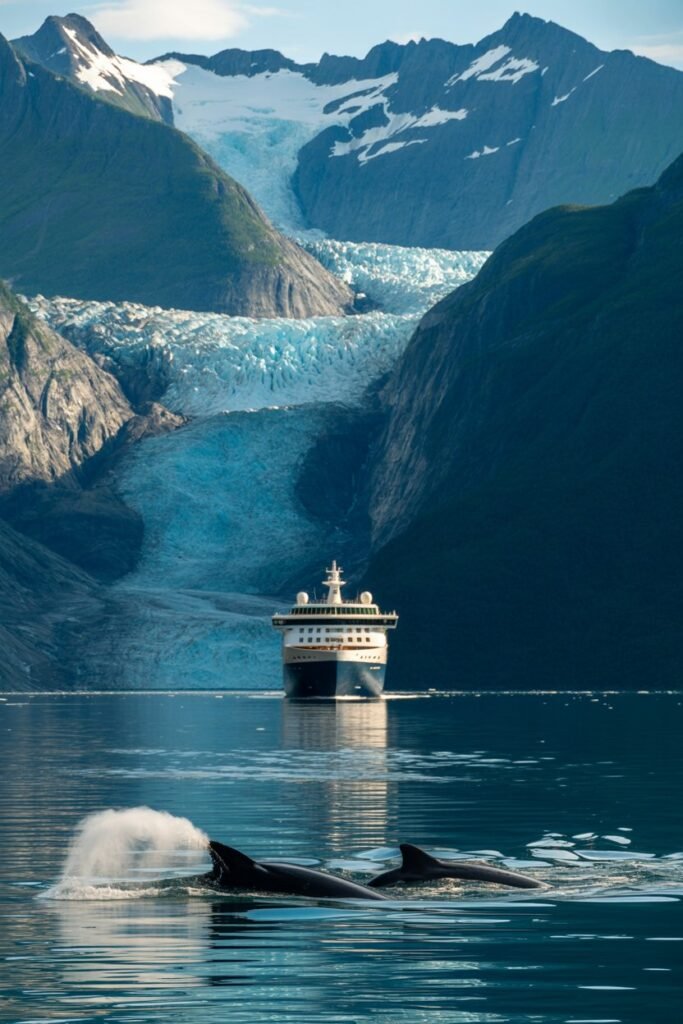
One-way cruises that venture further north provide opportunities to see less-visited regions and often offer enhanced wildlife viewing opportunities. Many travelers report unforgettable moments watching whales breach, sea otters play, and bald eagles soar along these routes [SOURCE].
Seasonal Operation
Alaska’s cruise season typically runs from May through September, aligning with the region’s most moderate weather and peak daylight hours. Most cruises operate on 7-day itineraries, either round-trip from Seattle or Vancouver, or one-way between Vancouver and Alaskan ports like Seward or Whittier [SOURCE].
Each part of the season offers different advantages:
- May and September: Lower prices and fewer crowds, but potentially cooler weather
- June: Peak daylight hours (nearly 24 hours in northern regions)
- July and August: Warmest temperatures and best wildlife viewing
Weather conditions are most stable during mid-summer, though Alaska’s weather can be unpredictable year-round. Plan accordingly and bring layers regardless of when you travel.
Travel Time & Logistics
Cruises provide a slower, more immersive journey to Alaska compared to flying. Most cruise itineraries last 7-14 days, with several days spent at sea enjoying the scenery. For many travelers, this relaxed pace is part of the appeal – the journey becomes as important as the destination.
Important logistical considerations include:
- Most guests fly into Anchorage and then use shuttles, buses, or the Alaska Railroad to access cruise ports [SOURCE]
- One-way cruises require planning for travel to your embarkation point and from your disembarkation point
- Neither Seward nor Whittier (common cruise endpoints) have commercial airports – transfers to Anchorage are necessary [SOURCE]
Cost Considerations and Route Choices
Cruising to Alaska represents a significant investment, with costs varying widely based on cruise line, cabin type, and itinerary. Budget options start around $800 per person for 7-day cruises (interior cabin, shoulder season), while luxury experiences can exceed $5,000 per person.
When comparing route options:
- Round-trip cruises from Seattle or Vancouver typically offer simpler logistics and lower overall transportation costs
- One-way cruises allow more time in Alaska waters but require “open-jaw” flights (flying into one city and out of another), which can be more expensive [SOURCE]
Flying to Alaska
Efficiency and Flexibility
Flying is by far the fastest way to reach Alaska, with direct flights to Anchorage available from many major U.S. cities. Flight times from the West Coast are approximately 3-4 hours, while flights from the East Coast typically take 7-8 hours with connections.
Key advantages of flying include:
- Year-round accessibility, unlike the seasonal limitations of cruises
- Flexibility to visit interior destinations like Fairbanks and Denali more easily
- Time efficiency for travelers with limited vacation days
Major airlines serving Alaska include Alaska Airlines, Delta, United, and American, with Ted Stevens Anchorage International Airport serving as the primary gateway [SOURCE]. Smaller regional airports serve communities like Juneau, Fairbanks, and Ketchikan, though some remote communities are served only by small bush planes.
Pairing with Additional Transport
Flying to Alaska typically marks the beginning of your Alaskan adventure rather than the entirety of it. Most visitors who fly to Alaska pair their air travel with additional transportation methods:
- Rental cars for independent exploration of road-accessible areas
- Alaska Railroad journeys between major destinations
- Bush planes to access remote lodges and national parks
- Ferry travel on the Alaska Marine Highway System
- Day cruises for glacier viewing and wildlife watching
This combination approach allows for flexible, customized itineraries that can incorporate both coastal and inland experiences [SOURCE].
How to Choose
Deciding between a cruise and flying to Alaska depends on your travel preferences, budget, and what you hope to experience. Consider these guidelines:
Choose a cruise if you:
- Value scenic coastal experiences and marine wildlife viewing
- Enjoy the convenience of having accommodations, dining, and transportation combined
- Prefer a more structured, planned experience
- Want to visit multiple coastal communities without handling the logistics yourself
Choose flying if you:
- Want to maximize your time actually in Alaska
- Plan to explore interior destinations like Denali National Park
- Prefer flexibility and independence in your itinerary
- Are traveling outside the May-September cruise season
Many travelers find that combining both options provides the best of both worlds – for example, flying to Alaska, spending time exploring by car or train, then taking a one-way cruise back to the Lower 48 [SOURCE]. This approach allows you to experience both the coastal and interior regions of this vast state.
Alaska Road Trip Guide and Local Transportation Options
Immersive Exploration
An Alaska road trip offers one of the most immersive ways to experience the state’s diverse landscapes. Unlike flying or cruising, driving puts you in direct contact with the environment, allowing for spontaneous stops at viewpoints, hiking trails, and wildlife sightings. The Alaska Highway System connects major destinations, though it’s worth noting that Alaska’s road network is limited compared to other states.
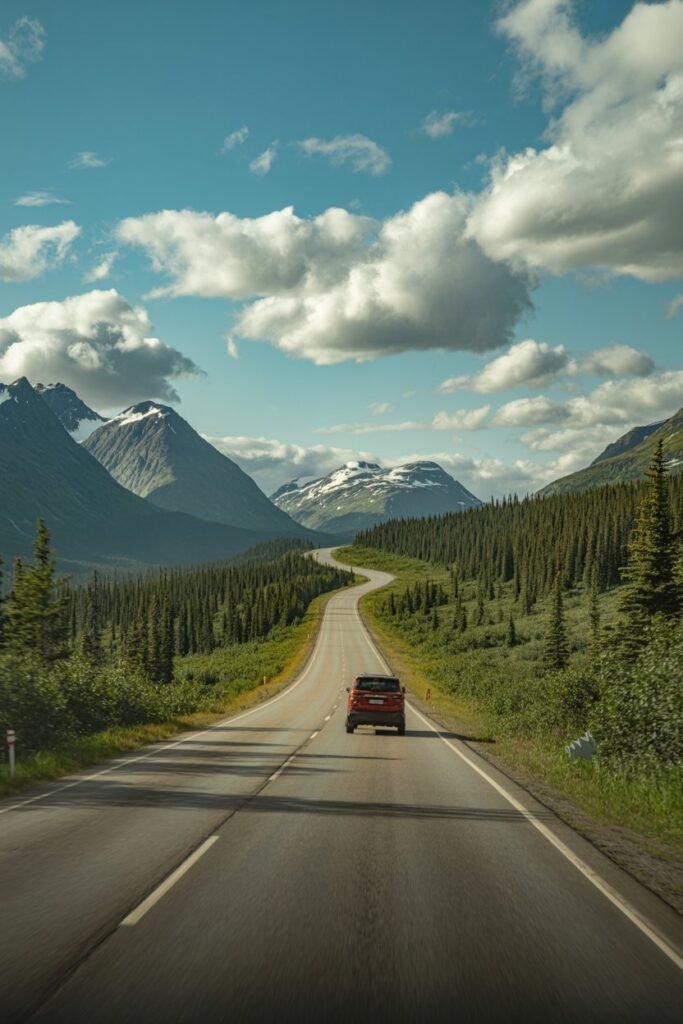
Key roadways for travelers include:
- The Glenn Highway connecting Anchorage to the Matanuska-Susitna Valley
- The Parks Highway linking Anchorage to Fairbanks, passing by Denali National Park
- The Richardson Highway connecting Fairbanks to Valdez
- The Seward Highway running from Anchorage to Seward along stunning Turnagain Arm
- The Sterling Highway traversing the Kenai Peninsula to Homer
These highways connect Alaska’s major cities and attractions, allowing travelers to create loop itineraries that showcase the state’s diverse regions [SOURCE].
However, it’s important to understand that many parts of Alaska remain off the road system entirely. Communities like Juneau (the state capital) cannot be reached by car from the mainland. Understanding these limitations is critical when planning an Alaska road trip.
Preparation Essentials
Road tripping in Alaska requires more preparation than driving in the Lower 48 states. The remote nature of many routes, variable road conditions, and limited services make advance planning crucial.
Navigation Tools
While digital navigation apps are helpful, they may not function in areas with limited cell service. Smart preparation includes:
- Physical maps of Alaska’s road system
- Offline maps downloaded to your mobile device
- A GPS device with Alaska maps pre-loaded
- The Milepost guidebook – considered the bible of Alaska road travel with detailed information on services and attractions along each mile
Emergency Supplies
Always carry these essentials, even in summer:
- Extra food and water for at least 24 hours
- Warm clothing layers and rain gear
- Emergency blankets
- Basic first aid kit
- Spare tire, jack, and tools
- Jumper cables
- Flashlight and extra batteries
- Cell phone charger and backup battery
- For remote areas, consider a satellite communication device
Fuel Planning
Gas stations can be separated by 100+ miles on some routes. A good rule of thumb is to refuel whenever your tank drops below half full. Make note of the locations of gas stations along your route, especially when traveling to more remote areas. Some rural stations may have limited hours or higher prices, so plan accordingly.
Weather Awareness
Alaska’s weather can change rapidly, affecting road conditions. Before setting out each day:
- Check current road conditions through the Alaska 511 system
- Review weather forecasts for your route
- Be prepared to adjust plans if conditions deteriorate
- In winter, verify that roads are open and maintained
Even summer travelers should be prepared for occasional snow at higher elevations, especially in mountain passes.
By preparing thoroughly for your Alaska road trip, you’ll be able to focus on enjoying the breathtaking landscapes rather than worrying about unexpected challenges.
Dalton Highway Road Trip: Challenges, Routes, and Preparation
Dalton Highway Significance
The Dalton Highway represents one of North America’s most adventurous and challenging road trips. Stretching 414 miles from near Fairbanks to Deadhorse at the Arctic Ocean, this remote route was built primarily as a supply road for the Trans-Alaska Pipeline System and Alaska’s northern oil fields [SOURCE].
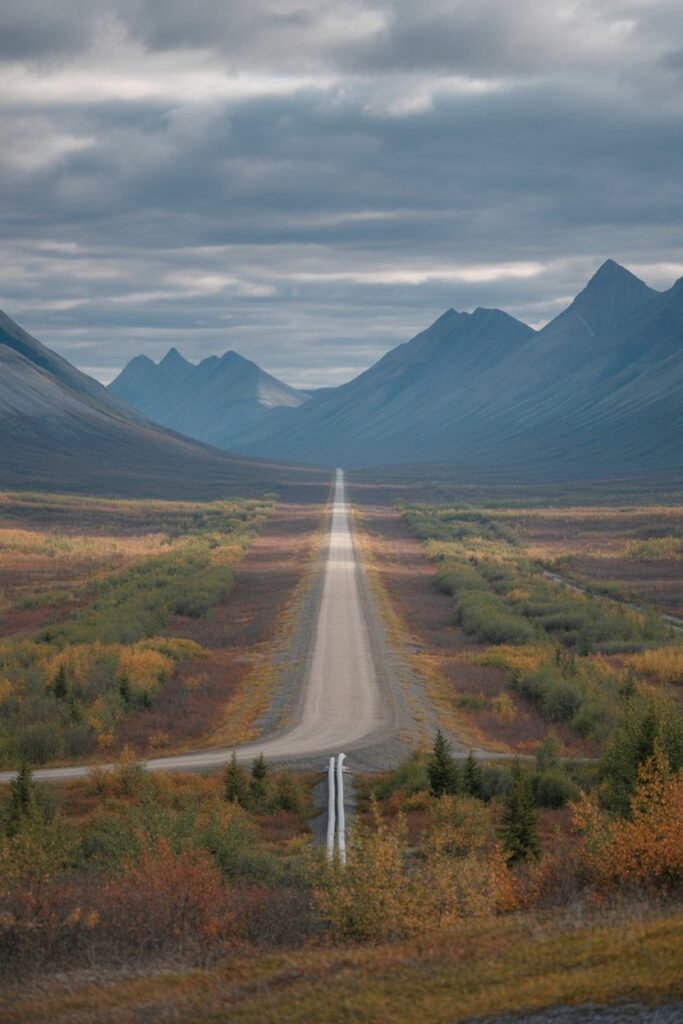
Unlike typical tourist routes, the Dalton Highway (also known as Alaska Route 11) passes through some of the most isolated wilderness in North America. It crosses the mighty Yukon River, traverses the Brooks Range via the dramatic Atigun Pass, and ends just shy of the Arctic Ocean at Prudhoe Bay.
What makes this highway truly special is the opportunity it provides to experience Alaska’s changing ecosystems – from the boreal forests near Fairbanks to the treeless arctic tundra of the North Slope. Along the way, travelers cross the Arctic Circle, a milestone few get to experience.
Much of the highway runs parallel to the Trans-Alaska Pipeline, offering a unique look at this engineering marvel that transports crude oil 800 miles from Prudhoe Bay to Valdez.
Practical Planning Tips
The Dalton Highway presents unique challenges that require serious preparation:
Fuel and Services
Gas stations are extremely limited along the route, with only three reliable options:
- Yukon River Camp (Mile 56)
- Coldfoot (Mile 175)
- Deadhorse (Mile 414)
The 240-mile stretch between Coldfoot and Deadhorse has no services whatsoever – no fuel, no food, no lodging. Carrying extra fuel is recommended, especially for vehicles with limited range [SOURCE].
Road Conditions
Only the first 50 miles of the highway are paved; the remainder is primarily gravel and dirt. Conditions can include:
- Washboarded surfaces that shake vehicles violently
- Potholes and sharp rocks that can damage tires
- Mud after rain that can make the road slippery
- Dust clouds from large trucks that reduce visibility
- Ice and snow, even in summer at higher elevations
Most rental car companies prohibit taking their vehicles on the Dalton Highway. Specialized rental companies offering appropriate vehicles should be sought out if you don’t have your own suitable vehicle.
Essential Supplies
Beyond standard emergency supplies, Dalton Highway travelers should carry:
- At least two full-size spare tires and the tools to change them
- Extra food and water for 3-4 days
- CB radio for communicating with trucks (Channel 19)
- Bug repellent (summer insects can be intense)
- Heavy-duty vehicle recovery equipment
- Satellite phone or communication device
Cell service is nonexistent for most of the route, making alternative communication methods essential for emergencies.
Scenic and Wildlife Expectations
The challenging conditions of the Dalton Highway are balanced by extraordinary natural experiences:
Landscapes
The route showcases Alaska’s diverse terrain, including:
- The broad Yukon River crossing, one of North America’s great waterways
- The rugged peaks of the Brooks Range
- The spectacular Atigun Pass, which cuts through mountains at 4,800 feet
- The seemingly endless expanse of Arctic tundra
- The Coastal Plain near the Arctic Ocean
Wildlife
Wildlife viewing opportunities are outstanding, with possible sightings including:
- Caribou herds migrating across the tundra
- Moose in wetland areas
- Dall sheep on mountain slopes
- Grizzly bears and black bears
- Arctic foxes and wolves
- Numerous bird species, including golden eagles and snowy owls
The Dalton Highway represents Alaska in its most raw and untamed form. For adventurous travelers willing to prepare thoroughly, it offers an unparalleled journey into America’s last great wilderness.
Alaska Travel Requirements and Getting Around Locally
Travel Requirements
While Alaska is part of the United States, its remote location and unique environment create special considerations for travelers. Understanding these requirements will help ensure a smooth journey.
Documentation
For domestic travelers (U.S. citizens), standard identification is sufficient:
- A valid driver’s license or state ID
- For air travel, a REAL ID-compliant license or passport
International visitors need:
- A valid passport
- Appropriate visas or ESTA (Electronic System for Travel Authorization) approval for visa-waiver countries
If you’re traveling to Alaska via Canada (driving the Alaska Highway or taking a cruise that stops at Canadian ports), you’ll need proper documentation for entering Canada, including a passport.
Permits for Special Activities
While general tourism doesn’t require special permits, certain activities do:
- Fishing licenses for both residents and non-residents
- Hunting licenses and tags, which often must be applied for well in advance
- Backcountry permits for overnight stays in certain national parks
- Special area permits for access to some wildlife refuges or preserves [SOURCE]
Vehicle Requirements
When renting or bringing your own vehicle to Alaska:
- Ensure it’s appropriate for your planned routes (4WD/AWD recommended for gravel roads and winter travel)
- Check that insurance coverage extends to Alaska (and Canada if driving the Alaska Highway)
- Verify if your rental agreement allows travel on gravel roads or highways like the Dalton
- Consider vehicles with higher clearance for unpaved roads
Local Transportation Options
Once in Alaska, travelers have several options for getting around locally, depending on their destination and preferences.
Rental Vehicles
Car rentals provide the most flexibility for exploring road-accessible areas:
- Available at all major airports and in larger towns
- Reserve well in advance, especially for summer travel
- SUVs and 4WD vehicles often book up first
- RV rentals are popular but should be reserved 6-12 months ahead for peak season
Major rental companies operate in Alaska, alongside local operators who may offer specialized vehicles better suited to Alaska’s conditions [SOURCE].
Public Transportation
Options vary by location:
- Anchorage has a public bus system covering the city and some surrounding areas
- Fairbanks offers limited bus service
- Smaller communities typically have minimal or no public transit
Shuttle Services
Many popular tourist areas offer shuttle services:
- Denali National Park uses a shuttle bus system for park access
- Hotel shuttles operate in major towns
- Airport shuttles connect to downtown areas and cruise ports [SOURCE]
Alaska Railroad
The Alaska Railroad provides passenger service connecting:
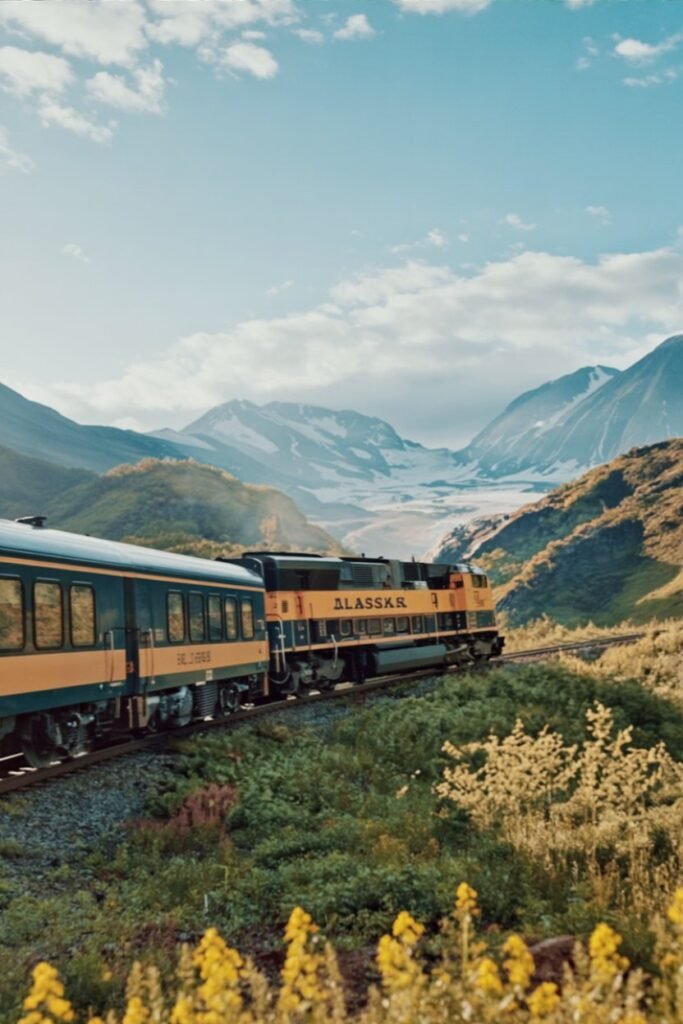
- Seward to Anchorage
- Anchorage to Denali National Park
- Denali to Fairbanks
The railroad offers standard service and premium GoldStar dome cars with panoramic views. It’s a scenic alternative to driving and particularly useful for cruise passengers connecting to interior destinations [SOURCE].
Ferry System
The Alaska Marine Highway System connects coastal communities throughout Southeast Alaska and extends to the Aleutian Islands. This ferry network serves as a critical transportation link for many towns not accessible by road, including Juneau. Ferries accommodate passengers, vehicles, and even RVs on many routes.
Air Taxis and Bush Planes
For remote areas without road access, small aircraft services provide essential connections:
- Scheduled air taxis between regional communities
- Charter flights to wilderness lodges, national parks, and fishing spots
- Flightseeing tours for scenic experiences
These services range from small single-engine planes to larger commuter aircraft depending on the destination [SOURCE].
Navigation & Information Resources
Staying informed during your Alaska travels is essential, particularly given the state’s variable conditions and remote areas.
Digital Resources
- Alaska 511 – Official state road condition information
- Weather apps with Alaska-specific forecasts
- Navigation apps with offline map capabilities
- National Park Service apps for park-specific information
Visitor Centers
Alaska’s visitor centers are valuable information hubs:
- State visitor centers in major cities and at border crossings
- National Park visitor centers for park-specific advice
- Local community visitor centers for area activities and conditions
Staff at these centers can provide current information about road conditions, wildlife sightings, and local attractions that may not be available online.
By understanding Alaska’s travel requirements and local transportation options, you can navigate this vast state more confidently and focus on enjoying its incredible natural beauty.
Frequently Asked Questions about Alaska Transportation & Accessibility
What is the best season to travel to Alaska for smoother transportation and road access?
The ideal time to visit Alaska is during the summer months from mid-May through September, when flights, ferries, and highways operate with fewer disruptions. This period offers warmer weather, longer daylight hours, and roads and ferry routes more likely to be fully operational. Shoulder seasons (May and September) often have fewer crowds and lower prices, but still some weather unpredictability. Winter travel is possible, especially for Northern Lights viewing, but expect more closures, limited daylight, and more challenging access to remote areas. Planning extra buffer days into your itinerary helps deal with delays.
How much should I budget for Alaska transportation, including cruises, flights, and road trips?
Transportation costs in Alaska vary depending on whether you choose cruises, flights, or road trips, and how remote your destinations are. A typical 7-day vacation combining flights or cruises, local transit, excursions, and lodging averages around **US $2,000–$4,200 per person**. Flights and cruises are usually the priciest components; once in Alaska, costs for car rental, ferries, bush planes, or train travel depend greatly on distance, season, and whether you travel independently or via guided tour. Early bookings and traveling during shoulder seasons can reduce transportation expenses.
Do I need permits, visas, or special documentation to visit Alaska or cross into Canada en route?
If you are a U.S. citizen, standard photo ID is sufficient for traveling within Alaska, but crossing into Canada requires a valid passport. U.S. citizens do not need a passport unless traveling through Canada. Non-U.S. citizens will require a valid passport, and possibly a visa or ESTA depending on nationality. Permits become necessary only for specific activities or protected lands: for example, backcountry permits in some national parks, fishing or hunting licenses, and approvals for entering restricted wildlife refuges. Always verify requirements for your specific itinerary especially if you cross international borders or aim to visit remote or protected areas.
What are the safest and most practical ways of getting around Alaska by car, train, ferry, or bush plane?
Each mode of local transportation in Alaska has pros and cons depending on the season, destination, and level of independence you prefer. Rental vehicles or SUVs are ideal for road-accessible destinations and provide flexibility, but off-road conditions, gravel/dirt roads, and sparse services demand preparation. The Alaska Railroad is excellent for scenic, comfortable travel between major hubs like Anchorage, Denali, Seward, and Fairbanks. Ferries, particularly the Alaska Marine Highway System, are essential for many coastal towns not connected by roads. For remote communities, air taxis or bush planes may be the only option. Check local schedules, equipment needs, and weather forecasts before choosing.
How should I prepare and what should I pack for an Alaska road trip, especially the Dalton Highway?
Preparation is critical for Alaska road trips—pack layered clothing, waterproof gear, sturdy boots, and extra fuel or navigation tools if traveling the Dalton Highway. For remote regions such as Dalton Highway, bring extra fuel, spare tires, emergency blankets, food and water for several days, a first-aid kit, and reliable navigation gear (offline maps, GPS, physical maps). Communication tools like satellite phones or radios are beneficial where cell coverage is minimal or nonexistent. Transportation-suitable vehicles (4WD/AWD, good clearance) are often necessary. Safety and redundancy are paramount in wilderness or isolated areas.
Conclusion
Traveling to Alaska requires thoughtful planning, but the variety of transportation choices ensures there is an option for every type of traveler. Cruises highlight the dramatic coastline and marine wildlife, while flights provide efficient year-round access to interior hubs such as Anchorage, Fairbanks, and Juneau. Road trips, including challenging routes like the Dalton Highway, offer immersive exploration but demand preparation for distance, weather, and limited services.
Each method of reaching and navigating Alaska comes with trade-offs in cost, convenience, and experience. Those seeking comfort and scenery often prefer cruises, while independent travelers with flexible itineraries may combine flying, driving, and train journeys to maximize their time.
Careful research into seasonal conditions, permits, and local infrastructure helps ensure safe and rewarding travel. To expand your planning beyond transportation, you may also find our detailed Alaska travel guide useful for exploring specific regions and activities.
With the right balance of logistics and adventure, a journey through Alaska offers unmatched access to vast wilderness, cultural heritage, and unforgettable landscapes.

